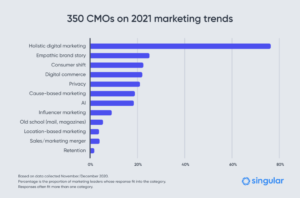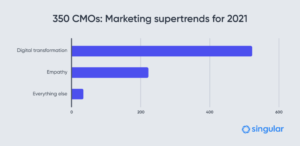350 CMOs on digital transformation of marketing: the task 2021 demands
Would you believe that Silicon Valley tech companies need digital transformation? Can you imagine that some of the hottest tech startups on the planet require digital transformation? Is it possible that digital transformation is not just the task of enterprise companies and legacy brands?
According to top CMOs at companies like Hotwire, LinkedIn, and iHeartMedia, absolutely.

Every year for the last half-decade, I’ve surveyed hundreds of CMOs on the hottest new technologies for marketing and advertising. Every year, they’ve given me the hot trendy sexy answers: the VRs and voice searches and augmented realities of marketing. In other words, everything trendy and hyped and … tactical.
Tactics are great. In fact, essential.
But unwrapped in a winning strategy, tactics are zero to 60 in three seconds flat to chasing your tail, wasting your budget, and ending up with cute case studies on multiple vendor-du-jour websites. But … not generating lasting, pervasive, and — perhaps most critically — continually compounding marketing advantage. And we wonder why there’s faster turnover at the CMO position than any other C-level executive role.
We generally hear about “digital transformation” in the context of companies of a certain age. Companies that don’t do business online, perhaps. Maybe that don’t have a mobile app, an Alexa Skill, or a podcast.
Do they need help? Sure.
Are all those things good? Yes.
But there’s something deeper that modern digital-first companies need. And it’s something most marketing departments in young tech-savvy companies also fail to achieve.
Most of even the best-run companies don’t:
- Have a single source of marketing truth
- Enrich first-party customer sales data with first-party customer support data
- Have omnichannel communications capability that connects with customers or prospects on their devices of choice in their channels of choice at their times of opportunity
- Connect all their marketing tools
- Consolidate marketing data in a clean, unified, accessible source
- Enjoy real-time insight into customer health
- Know their exact cost of customer acquisition by channel, and which channels are trending better over time
- And much more …
Unfortunately, 2020 was a horrific, ghastly year. So much changed in just a few months, and we’re not out of the woods yet. But something in marketing technology changed in 2020, too. Marketing changed for the usual reason most things change.
It had to.
And the CMOs I surveyed knew it. They understood that the time for flashy tactics is over. That in a down economy there was no room for flashy tactics that don’t impact the bottom line and don’t translate into lasting competitive advantage. Ultimately, CMOs realized en masse that the time for a holistic data-driven approach to complete marketing digital transformation is past due. The global pandemic wiped out the air cover for hype cycle tech, and what’s left is a burning platform to get real about sustainable holistic change.
“Finally, all the sacred cows are dead,” Openpath CMO Kieran Hannon to me. “Now meaningful customer-centric digital transformation can accelerate.”
It starts with digital, says VP of Marketing at LinkedIn Penry Price.
“We’ve learned during this pandemic that we can communicate over digital platforms better than we thought,” he said.

But it must include some degree of unification. Look: not everything can or needs to be connected at all times. Innovation needs space and time, and sometimes you need to break something creatively to blaze a new trail. But sustainable marketing effectiveness requires connection. Isolated data and isolated systems have isolated impact that is unsustainable over the long term; successful innovation infuses new insights and capabilities into a context where they can be understood, applied, and acted upon globally.
“Fusion is the new ecosystem,” says Suzanne Kounkel, Chief Marketing Officer for Deloitte. “Fusion is the art of bringing together new business partnerships, customer insights, and digital platforms to create ecosystems.”
Marketers have long had systems of analysis and systems of engagement. Isolated systems of analysis lead to knowledge without action. Isolated systems of engagement lead to action without knowledge. Both are clearly not great by any standard. But also bad are one-way systems. One-way systems feed analysis into engagement, but don’t report back results. One way systems take action, but don’t update analysis. Both slow institutional learning at a time when brands need to learn, improve, and engage at internet speed
Unfortunately, both are easy to achieve. In fact, they’re the default result of chasing every new hyped technology that doesn’t in some way connect back to the core.
The core is digital transformation in marketing.
And that means holistic digital marketing: marketing where you comprehensively understand customer touchpoints when and where it’s privacy-safe. Where you exhaustively manage your marketing activity, spend, and results in privacy-safe ways across all channels, modes, and methodologies. Where your systems of analysis and systems of engagement are aligned and integrated, shortening the span between awareness and action.
Google learns from each search. Facebook learns every time someone posts. Tesla learns every time a driver takes a seat. In just the same way, good marketing organizations are wired to learn from ongoing engagements and touchpoints in real time. Every engagement makes you smarter about what customers want. Every click provides data. Every view contributes to insight.
Anything less, and you’re learning slower than your competition.
That does include investment and innovation. As iHeartMedia executive VP Hetal Thaker Patel says, “it’s critical for consumer-facing companies to invest in data and insight tools to stay ahead of the trends.” But those investments need to connect islands of data and siloes of engagement.
Then we’re seeing the whole customer, or as much as she or he chooses to reveal. And we’re seeing the whole of our marketing activity, combined with its results.
“The first place to start would be examining lifecycle marketing programs to ensure that everything from onboarding to reengagement campaigns create relevant and memorable experiences that engage customers, build stronger loyalty and drive ROI,” says Myles Kleeger, President and chief customer officer at Braze.
It’s not about an app. It’s not about a website. It’s not about a social initiative.
It’s about how they all work together.
“That was so 2020, where every business scrambled to become digital and mobile-first,” says Cynthia Gumbert, CMO at SmartBear. “That’s quickly becoming old news, and the biggest thing differentiating businesses is how well these digital experiences now operate for their customers.”
Every touchpoint is a glance at your brand’s face. But for most brands, customers’ experience with them in different channels is like the old story of the person who views an elephant through a fence, and while they see a leg and a trunk and a tail, can’t figure out how they all fit together. That doesn’t accomplish anything for your brand but frustrate your customers and dilute your brand.
“The strategy for 2021 needs to be an alignment of all platforms and initiatives, and in many cases, an increased focus on centralizing and utilizing the data each of these programs is producing to better drive execution,” says Shawn Rogers, a marketing VP at TIBCO. “Just having the newest tool isn’t the answer either — it’s a challenge to bring the data together in a way that drives innovation.”
You have the data required to drive the insights you need.
The way to activate it is to bring it all together.
As Axway CMO Paul French told me, the next big trend is liberating the value locked up in your martech stack.
Stay up to date on the latest happenings in digital marketing


